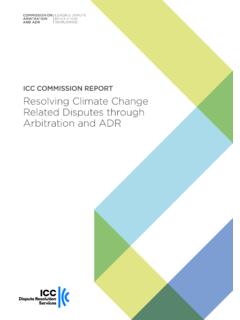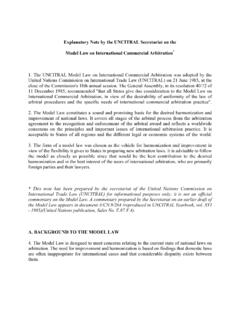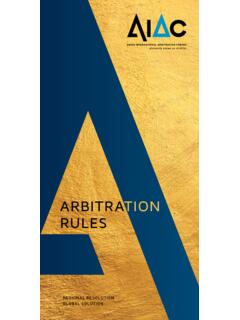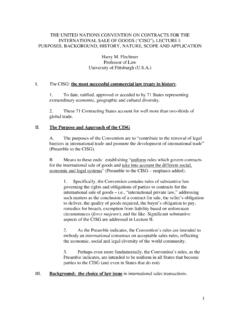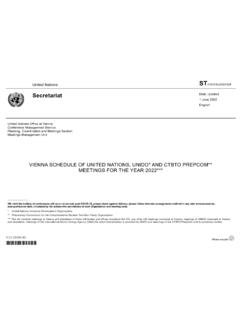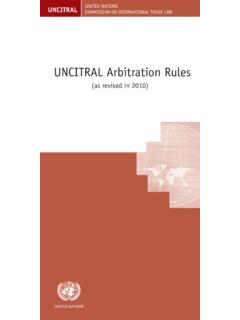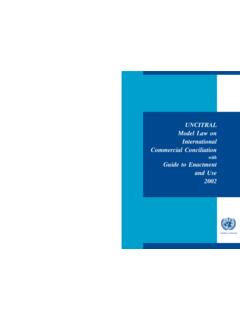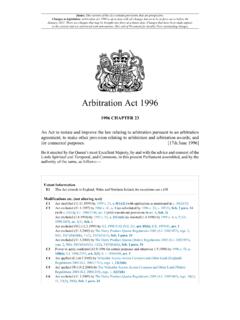Transcription of UNCITRAL Secretariat Guide on the Convention on the ...
1 UNCITRALUNITED NATIONS COMMISSION ON INTERNATIONAL TRADE LAWUNITED NATIONSUNCITRAL Secretariat Guide on the Convention on the Recognition and Enforcement of Foreign Arbitral Awards(New York, 1958)Further information may be obtained from: UNCITRAL Secretariat , Vienna International Centre, Box 500, 1400 Vienna, AustriaTelephone: (+43-1) 26060-4060 Telefax: (+43-1) 26060-5813 Internet: E-mail: Secretariat Guide on the Convention on the Recognition and Enforcement of Foreign Arbitral Awards (New York, 1958)2016 EditionUNITED NATIONS New York, 2016 UNITED NATIONS COMMISSION ON INTERNATIONAL TRADE LAWUNITED NATIONS PUBLICATIONS ales No.: : 978-92-1-133851-5e-ISBN: 978-92-1-058318-3 NoteSymbols of United Nations documents are composed of capital letters com-bined with figures. Mention of such a symbol indicates a reference to a United Nations document.
2 United Nations, September 2016. All rights reserved, Guide is a product of the work of the Secretariat based on expert input, and was not substantively discussed by the United Nations Commission on Interna-tional Trade Law ( UNCITRAL ). Accordingly, the Guide does not purport to reflect the views or opinions of UNCITRAL member States and does not consti-tute an official interpretation of the New York designations employed and the presentation of material in this publication do not imply the expression of any opinion whatsoever on the part of the Secretariat of the United Nations concerning the legal status of any country, territory, city or area, or of its authorities, or concerning the delimitation of its frontiers or production: English, Publishing and Library Section, United Nations Office at PagePreface.
3 IxIntroduction .. 1 Article I .. 5 Article I (1) .. 9A. Meaning of recognition and enforcement .. 9B. Meaning of arbitral awards .. 11C. Arbitral awards falling within the scope of the Convention .. 18D. Meaning of arising out of differences .. 27 Article I (2) .. 28 Article I (3) .. 29A. Reciprocity reservation .. 29B. Commercial reservation.. 33 Article II .. 37 Article II (1) .. 42A. The obligation to recognize an agreement in writing .. 42B. Meaning of agreement .. 43C. Scope of the agreement in writing .. 48 Article II (2) .. 51A. Arbitral clause in a contract versus arbitration agreement .. 52B. The signature requirement .. 53C. An arbitral clause or an arbitration agreement included in an exchange of documents .. 54ivArticle II (3) .. 57A. General principles .. 57B. Enforcement of arbitration agreements under article II (3).
4 62 Article III .. 75A. General principles .. 78B. Rules of procedure of the territory where the award is relied upon .. 82C. There should not be imposed substantially more onerous conditions or higher fees or charges than are imposed on the recognition or enforcement of domestic arbitral awards .. 90 Article IV .. 95A. Prima facie right to recognition and enforcement .. 99B. An exhaustive set of requirements .. 99C. Whether applicants can supply some, but not all, article IV documents .. 101D. [A]t the time of the application .. 103 Article IV (1)(a) .. 105A. The requirement that the applicant provide the award .. 105B. Authentication and certification .. 108 Article IV (1)(b) .. 113A. The requirement that the applicant provide the arbitration agreement referred to in article II .. 114B. No requirement to prove the validity of the arbitration agreement.
5 115C. No requirement to authenticate the arbitration agreement .. 116 Article IV (2) .. 117A. Governing law .. 117B. Certification by an official or sworn translator or by a diplomatic or consular agent .. 118C. The object of translation .. 119vArticle V .. 121A. Court discretion under article V .. 125B. Exhaustive character of grounds under article V .. 126C. Burden of proof under article V .. 128 Article V (1)(a) .. 131 Incapacity of the parties .. 134A. Meaning of the parties to the agreement referred to in article II .. 134B. Concept of incapacity .. 135C. Meaning of the law applicable to them .. 138D. Relevant time for incapacity .. 140 Invalidity of the arbitration agreement .. 141A. The choice of law rule under article V (1)(a) .. 141B. Meaning of invalidity .. 144C. Formal validity of an arbitration agreement .. 145 Procedural issues arising in connection with article V (1)(a).
6 146A. Burden of proof .. 146B. Relevance of the findings of arbitral tribunals or courts .. 148C. Preclusion .. 150 Article V (1)(b) .. 153A. The requirement that the parties be given proper notice .. 157B. Evidence that a party was unable to present his case .. 163C. Procedural hurdles to showing a breach of article V (1)(b) .. 168 Article V (1)(c ) .. 171A. General principles .. 174B. Partial recognition of an award .. 181C. Relationship with other articles in the Convention .. 182D. Procedural aspects .. 184viArticle V (1)(d ) .. 187 General principles .. 191A. Prevalence of party autonomy .. 191B. Subsidiary role of the law of the country where the arbitration took place .. 193 Application .. 195A. The requirement that the composition of the arbitral tribunal accord with the governing rules .. 195B. The requirement that the arbitral procedure accord with the governing rules.
7 198C. Procedural issues in raising a challenge based on article V (1)(d ) ..202 Article V (1)(e ) .. 205A. The binding nature of an award .. 209B. What is a competent authority of the country in which, or under the law of which , the award was made? .. 217C. Award set aside or suspended .. 220 Article V (2)(a) .. 225A. Concept .. 228B. Application .. 231 Article V (2)(b) .. 237A. Concept .. 240B. Application .. 247C. Procedural issues in raising the defence of article V (2)(b) .. 256 Article VI .. 263A. General principles .. 266B. The decision to grant or deny adjournment .. 271C. The decision to order suitable security .. 279 Article VII .. 287viiArticle VII (1) .. 289A. General principles .. 290B. Interaction of the Convention with other treaties .. 293C. Interaction of the Convention with domestic law .. 298 Article VII (2) .. 307 Article VIII .. 309 Article VIII (1).
8 310 Article VIII (2) .. 311A. Procedure for becoming a party .. 311B. Depositary .. 312 Article IX .. 313 Article X .. 315 Article XI .. 317 Article XII .. 321 Article XIII .. 325 Article XIV .. 327 Article XV .. 331 Article XVI .. 333ixPrefaceFrom the Final Act of the United Nations Conference on International Commercial Arbitration of 10 June 1958 to General Assembly resolution 62/65 of 6 December 20071. The New York Convention on the Recognition and Enforcement of Foreign Arbitral Awards (the New York Convention or the Convention ) is one of the most important and successful United Nations treaties in the area of international trade law. Although the Convention , adopted by diplomatic conference on 10 June 1958, was prepared by the United Nations prior to the establishment of the United Nations Commission on International Trade Law ( UNCITRAL ), promotion of the Convention is an integral part of the work programme of UNCITRAL .
9 The Convention is widely recognized as a foundational instrument of international arbi-tration and requires courts of contracting States to give effect to an agreement to arbitrate when seized of an action in a matter covered by an arbitration agreement and also to recognize and enforce awards made in other States, subject to specific limited exceptions. The Convention entered into force on 7 June 1959, and there are to date 156 States parties to the The General Assembly adopted on 6 December 2007 resolution 62/65 in which it recognized the value of arbitration as a method of settling disputes in international commercial relations in a manner that contributes to harmonious commercial relations, stimulates international trade and development, and pro-motes the rule of law at the international and national levels.
10 The General Assembly expressed its conviction that the New York Convention strengthens respect for binding commitments, inspires confidence in the rule of law and ensures fair treat-ment in the resolution of disputes arising over contractual rights and obligations. It emphasized the necessity for further national efforts to achieve universal adher-ence to the Convention , together with its uniform interpretation and effective implementation. The General Assembly expressed its hope that States that are not yet parties to the Convention would soon become parties to it, which would ensure that the legal certainty afforded by the Convention is universally enjoyed, and xwould decrease the level of risk and transactional costs associated with doing busi-ness, thus promoting international trade. 3. The General Assembly requested the Secretary-General to increase efforts to promote wider adherence to the Convention and its uniform interpretation and effective implementation.
